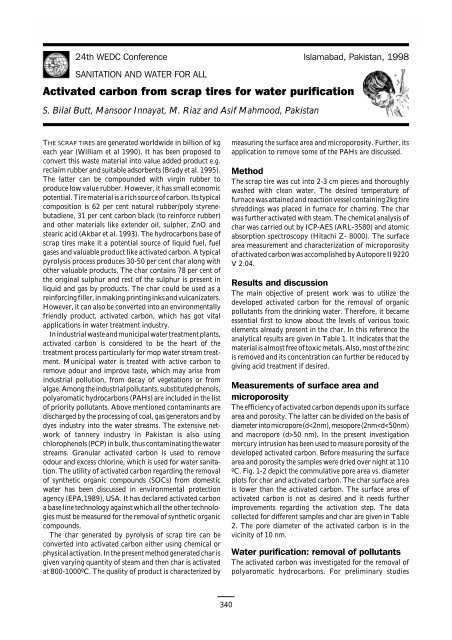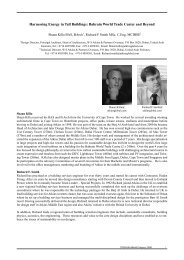Activated carbon from scrap tires for water purification - WEDC
Activated carbon from scrap tires for water purification - WEDC
Activated carbon from scrap tires for water purification - WEDC
Create successful ePaper yourself
Turn your PDF publications into a flip-book with our unique Google optimized e-Paper software.
T WATER TREATMENT: BUTT, INNAYAT, RIAZ and MAHMOOD<br />
24th <strong>WEDC</strong> Conference Islamabad, Pakistan, 1998<br />
SANITATION AND WATER FOR ALL<br />
<strong>Activated</strong> <strong>carbon</strong> <strong>from</strong> <strong>scrap</strong> <strong>tires</strong> <strong>for</strong> <strong>water</strong> <strong>purification</strong><br />
S. Bilal Butt, Mansoor Innayat, M. Riaz and Asif Mahmood, Pakistan<br />
THE SCRAP TIRES are generated worldwide in billion of kg<br />
each year (William et al 1990). It has been proposed to<br />
convert this waste material into value added product e.g.<br />
reclaim rubber and suitable adsorbents (Brady et al. 1995).<br />
The latter can be compounded with virgin rubber to<br />
produce low value rubber. However, it has small economic<br />
potential. Tire material is a rich source of <strong>carbon</strong>. Its typical<br />
composition is 62 per cent natural rubber/poly styrenebutadiene,<br />
31 per cent <strong>carbon</strong> black (to rein<strong>for</strong>ce rubber)<br />
and other materials like extender oil, sulpher, ZnO and<br />
stearic acid (Akbar et al. 1993). The hydro<strong>carbon</strong>s base of<br />
<strong>scrap</strong> <strong>tires</strong> make it a potential source of liquid fuel, fuel<br />
gases and valuable product like activated <strong>carbon</strong>. A typical<br />
pyrolysis process produces 30-50 per cent char along with<br />
other valuable products. The char contains 78 per cent of<br />
the original sulphur and rest of the sulphur is present in<br />
liquid and gas by products. The char could be used as a<br />
rein<strong>for</strong>cing filler, in making printing inks and vulcanizaters.<br />
However, it can also be converted into an environmentally<br />
friendly product, activated <strong>carbon</strong>, which has got vital<br />
applications in <strong>water</strong> treatment industry.<br />
In industrial waste and municipal <strong>water</strong> treatment plants,<br />
activated <strong>carbon</strong> is considered to be the heart of the<br />
treatment process particularly <strong>for</strong> mop <strong>water</strong> stream treatment.<br />
Municipal <strong>water</strong> is treated with active <strong>carbon</strong> to<br />
remove odour and improve taste, which may arise <strong>from</strong><br />
industrial pollution, <strong>from</strong> decay of vegetations or <strong>from</strong><br />
algae. Among the industrial pollutants, substituted phenols,<br />
polyaromatic hydro<strong>carbon</strong>s (PAHs) are included in the list<br />
of priority pollutants. Above mentioned contaminants are<br />
discharged by the processing of coal, gas generators and by<br />
dyes industry into the <strong>water</strong> streams. The extensive network<br />
of tannery industry in Pakistan is also using<br />
chlorophenols (PCP) in bulk, thus contaminating the <strong>water</strong><br />
streams. Granular activated <strong>carbon</strong> is used to remove<br />
odour and excess chlorine, which is used <strong>for</strong> <strong>water</strong> sanitation.<br />
The utility of activated <strong>carbon</strong> regarding the removal<br />
of synthetic organic compounds (SOCs) <strong>from</strong> domestic<br />
<strong>water</strong> has been discussed in environmental protection<br />
agency (EPA,1989), USA. It has declared activated <strong>carbon</strong><br />
a base line technology against which all the other technologies<br />
must be measured <strong>for</strong> the removal of synthetic organic<br />
compounds.<br />
The char generated by pyrolysis of <strong>scrap</strong> tire can be<br />
converted into activated <strong>carbon</strong> either using chemical or<br />
physical activation. In the present method generated char is<br />
given varying quantity of steam and then char is activated<br />
at 800-1000ºC. The quality of product is characterized by<br />
measuring the surface area and microporosity. Further, its<br />
application to remove some of the PAHs are discussed.<br />
Method<br />
The <strong>scrap</strong> tire was cut into 2-3 cm pieces and thoroughly<br />
washed with clean <strong>water</strong>. The desired temperature of<br />
furnace was attained and reaction vessel containing 2kg tire<br />
shreddings was placed in furnace <strong>for</strong> charring. The char<br />
was further activated with steam. The chemical analysis of<br />
char was carried out by ICP-AES (ARL-3580) and atomic<br />
absorption spectroscopy (Hitachi Z- 8000). The surface<br />
area measurement and characterization of microporosity<br />
of activated <strong>carbon</strong> was accomplished by Autopore II 9220<br />
V 2.04.<br />
Results and discussion<br />
The main objective of present work was to utilize the<br />
developed activated <strong>carbon</strong> <strong>for</strong> the removal of organic<br />
pollutants <strong>from</strong> the drinking <strong>water</strong>. There<strong>for</strong>e, it became<br />
essential first to know about the levels of various toxic<br />
elements already present in the char. In this reference the<br />
analytical results are given in Table 1. It indicates that the<br />
material is almost free of toxic metals. Also, most of the zinc<br />
is removed and its concentration can further be reduced by<br />
giving acid treatment if desired.<br />
Measurements of surface area and<br />
microporosity<br />
The efficiency of activated <strong>carbon</strong> depends upon its surface<br />
area and porosity. The latter can be divided on the basis of<br />
diameter into micropore (d
T WATER TREATMENT: BUTT, INNAYAT, RIAZ and MAHMOOD<br />
naphthalen and anthracene were selected. <strong>Activated</strong> <strong>carbon</strong><br />
columns (i.d. 5mm) of variable height were prepared<br />
and solution containing 50 ppb anthracene and 1000 ppb<br />
naphthalene was passed through these columns of activated<br />
<strong>carbon</strong>. The column of 1 gram activated <strong>carbon</strong> was<br />
found best regarding the retention of these pollutants. The<br />
collected volumes were scanned using photometer. The<br />
fractions containing eluted naphthalene and anthracene<br />
were analyzed by HPLC as shown in Fig.3. Based on these<br />
analyses it was concluded that column bed of 1 gram<br />
activated <strong>carbon</strong> has retained 99 per cent naphthalene and<br />
98 per cent anthracene. These data indicated that a waste<br />
product could be converted in to a value-added product.<br />
References<br />
AKBAR A, MERCHANT, M.A.PETRICH (1993). “Pyrolysis<br />
of <strong>scrap</strong> <strong>tires</strong> and conversion of char to activated<br />
<strong>carbon</strong>”. AlChE Journal Vol. 39(8), pp1370-76.<br />
BRADY TODD A. ROSTAN ABDI, MASSUD S.JAN,<br />
ROOD MARK J (1995), “Development of adsorbent<br />
<strong>carbon</strong> <strong>from</strong> waste <strong>tires</strong> <strong>for</strong> natural gas storage and<br />
multicomponents air pollution control”, Air and waste<br />
management association, Vol. 16, 95-T P 5102.<br />
Report no. EPA, PB. 91,223321, 1989, USA,<br />
WILLIAM, PT et al (1990), “The pyrolysis of <strong>scrap</strong> automotive<br />
<strong>tires</strong>: The influence of temperature and heating<br />
rate on product composition”, Fuel, 69, 1474.<br />
Conclusion<br />
The activated <strong>carbon</strong> produced has lower surface area.<br />
However, it exhibited a potential to remove trace level<br />
impurities present in ground<strong>water</strong> and slightly polluted<br />
surface <strong>water</strong>. Further work is in progress to improve the<br />
surface area and microporosity of activated <strong>carbon</strong> <strong>for</strong> its<br />
improved per<strong>for</strong>mance in other areas of interest.<br />
SHAHID BILAL BUTT, Nuclear Chemistry Division, Pakistan<br />
Institute of Nuclear Science and Technology.<br />
MANSOOR INNAYAT, Pakistan Institute of Engineering<br />
and Applied Sciences.<br />
MOHAMMED RIAZ, Nuclear Chemistry Division, Pakistan<br />
Institute of Nuclear Science and Technology.<br />
ASIF MAHMOOD, Nuclear Chemistry Division, Pakistan<br />
Institute of Nuclear Science and Technology.<br />
Table 1. Analysis of various toxic metals (ppm) in activated <strong>carbon</strong> <strong>from</strong> <strong>scrap</strong> tire<br />
Table 2. Pyrolysis conditions and characterization of char and activated <strong>carbon</strong> <strong>from</strong> <strong>scrap</strong> tire<br />
341
T WATER TREATMENT: BUTT, INNAYAT, RIAZ and MAHMOOD<br />
Figure 1. Measurement of surface area and<br />
porosity of char <strong>from</strong> waste <strong>tires</strong><br />
Figure 2. Measurement of surface area and porosity of<br />
activated <strong>carbon</strong> <strong>from</strong> waste <strong>tires</strong><br />
Figure 3. Elution behavior of polyaromatic hydro<strong>carbon</strong>s on Lichrosorb-Rp-8, column (4.6x250 mm) 10 mm particle size.<br />
Eluant: 80 per cent methanol-<strong>water</strong>, l max<br />
254 nm, Flow rate: 0.8 ml min -1<br />
342



